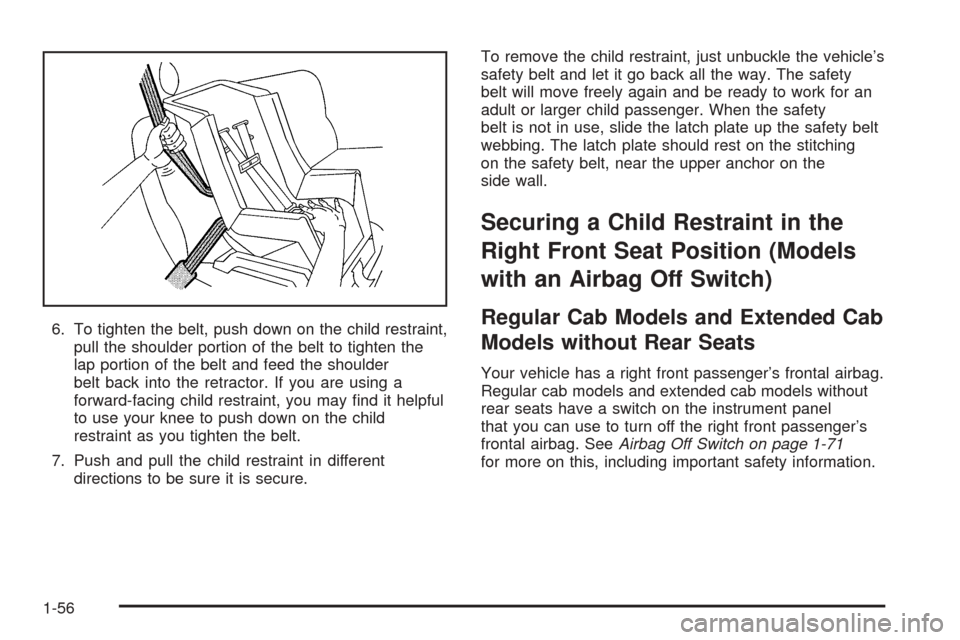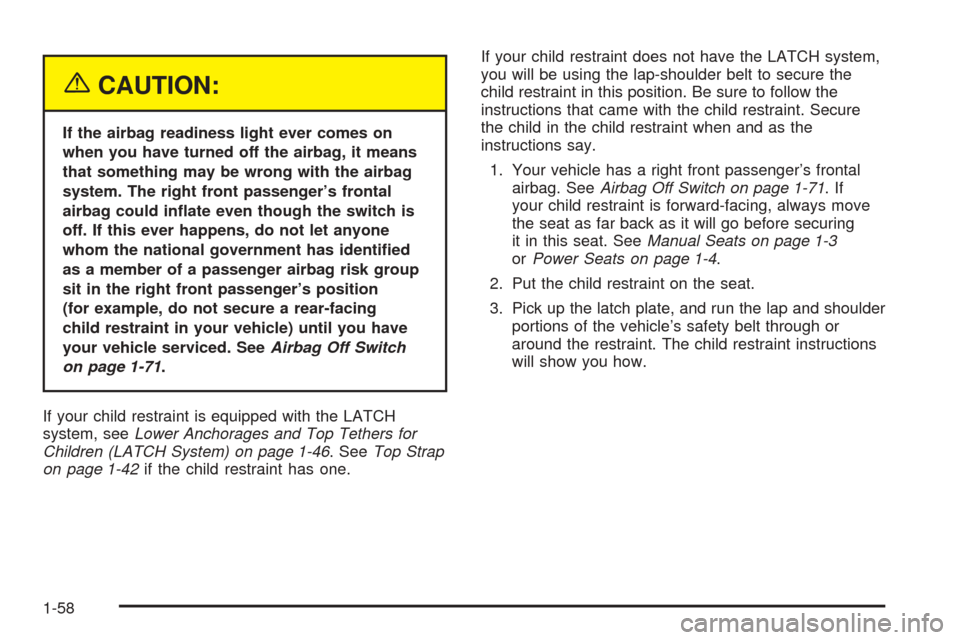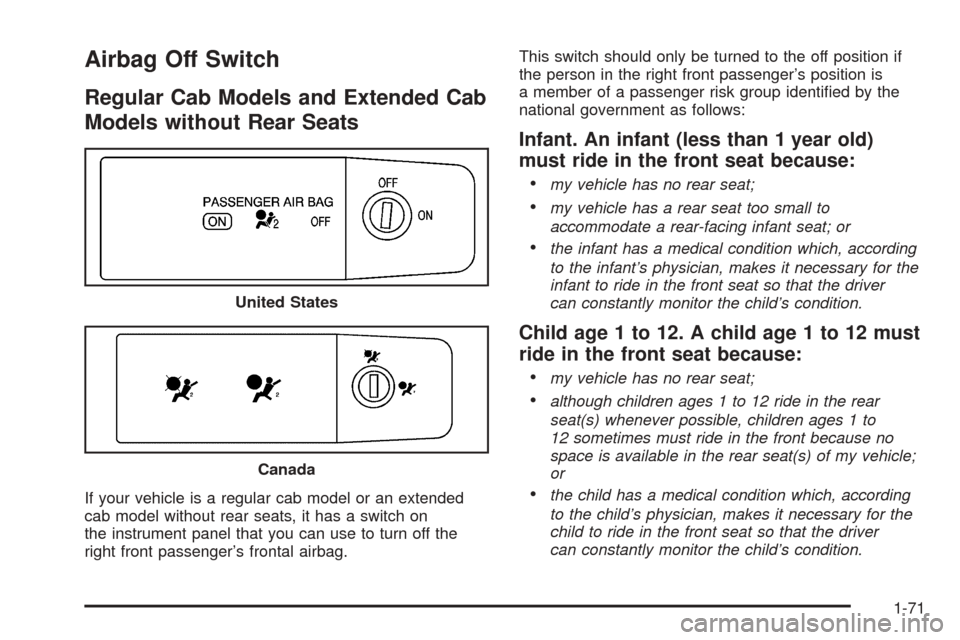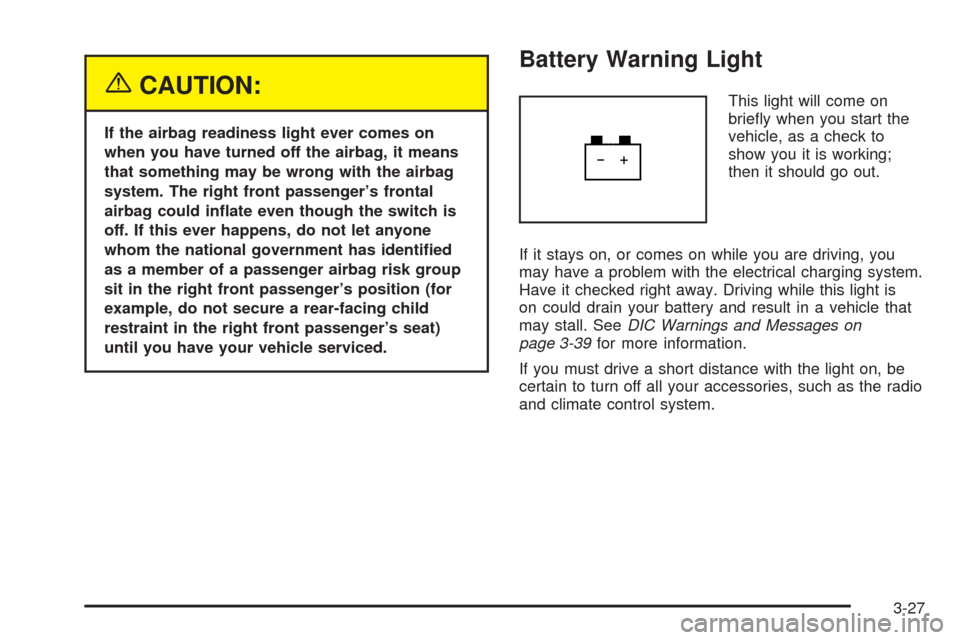Page 61 of 414
2. Put the child restraint on the seat.
3. Pick up the latch plate, and run the lap and shoulder
portions of the vehicle’s safety belt through or
around the restraint. The child restraint instructions
will show you how.
4. Buckle the belt. Make sure the release button is
positioned so you would be able to unbuckle the
safety belt quickly if you ever had to.5. Pull the rest of the shoulder belt all the way out of
the retractor to set the lock.
1-55
Page 62 of 414

6. To tighten the belt, push down on the child restraint,
pull the shoulder portion of the belt to tighten the
lap portion of the belt and feed the shoulder
belt back into the retractor. If you are using a
forward-facing child restraint, you may �nd it helpful
to use your knee to push down on the child
restraint as you tighten the belt.
7. Push and pull the child restraint in different
directions to be sure it is secure.To remove the child restraint, just unbuckle the vehicle’s
safety belt and let it go back all the way. The safety
belt will move freely again and be ready to work for an
adult or larger child passenger. When the safety
belt is not in use, slide the latch plate up the safety belt
webbing. The latch plate should rest on the stitching
on the safety belt, near the upper anchor on the
side wall.
Securing a Child Restraint in the
Right Front Seat Position (Models
with an Airbag Off Switch)
Regular Cab Models and Extended Cab
Models without Rear Seats
Your vehicle has a right front passenger’s frontal airbag.
Regular cab models and extended cab models without
rear seats have a switch on the instrument panel
that you can use to turn off the right front passenger’s
frontal airbag. SeeAirbag Off Switch on page 1-71
for more on this, including important safety information.
1-56
Page 63 of 414
Unless the right front passenger’s frontal airbag has
been turned off, never put a rear facing child restraint
in the right front passenger’s seat. Here is why:
{CAUTION:
A child in a rear-facing child restraint can be
seriously injured or killed if the right front
passenger’s frontal airbag in�ates. This is
because the back of the rear-facing child
restraint would be very close to the in�ating
airbag. Do not use a rear-facing child restraint
in this vehicle unless the airbag has been
turned off.
Even though the airbag off switch is designed
to turn off the right front passenger’s frontal
airbag, no system is fail-safe, and no one can
guarantee that an airbag will not deploy under
some unusual circumstance, even though it is
turned off. We recommend that rear-facing
child restraints be transported in vehicles with
a rear seat that will accommodate a rear-facing
child restraint, whenever possible. United States
Canada
1-57
Page 64 of 414

{CAUTION:
If the airbag readiness light ever comes on
when you have turned off the airbag, it means
that something may be wrong with the airbag
system. The right front passenger’s frontal
airbag could in�ate even though the switch is
off. If this ever happens, do not let anyone
whom the national government has identi�ed
as a member of a passenger airbag risk group
sit in the right front passenger’s position
(for example, do not secure a rear-facing
child restraint in your vehicle) until you have
your vehicle serviced. SeeAirbag Off Switch
on page 1-71.
If your child restraint is equipped with the LATCH
system, seeLower Anchorages and Top Tethers for
Children (LATCH System) on page 1-46. SeeTop Strap
on page 1-42if the child restraint has one.If your child restraint does not have the LATCH system,
you will be using the lap-shoulder belt to secure the
child restraint in this position. Be sure to follow the
instructions that came with the child restraint. Secure
the child in the child restraint when and as the
instructions say.
1. Your vehicle has a right front passenger’s frontal
airbag. SeeAirbag Off Switch on page 1-71.If
your child restraint is forward-facing, always move
the seat as far back as it will go before securing
it in this seat. SeeManual Seats on page 1-3
orPower Seats on page 1-4.
2. Put the child restraint on the seat.
3. Pick up the latch plate, and run the lap and shoulder
portions of the vehicle’s safety belt through or
around the restraint. The child restraint instructions
will show you how.
1-58
Page 77 of 414

Airbag Off Switch
Regular Cab Models and Extended Cab
Models without Rear Seats
If your vehicle is a regular cab model or an extended
cab model without rear seats, it has a switch on
the instrument panel that you can use to turn off the
right front passenger’s frontal airbag.This switch should only be turned to the off position if
the person in the right front passenger’s position is
a member of a passenger risk group identi�ed by the
national government as follows:
Infant. An infant (less than 1 year old)
must ride in the front seat because:
my vehicle has no rear seat;
my vehicle has a rear seat too small to
accommodate a rear-facing infant seat; or
the infant has a medical condition which, according
to the infant’s physician, makes it necessary for the
infant to ride in the front seat so that the driver
can constantly monitor the child’s condition.
Child age 1 to 12. A child age 1 to 12 must
ride in the front seat because:
my vehicle has no rear seat;
although children ages 1 to 12 ride in the rear
seat(s) whenever possible, children ages 1 to
12 sometimes must ride in the front because no
space is available in the rear seat(s) of my vehicle;
or
the child has a medical condition which, according
to the child’s physician, makes it necessary for the
child to ride in the front seat so that the driver
can constantly monitor the child’s condition. United States
Canada
1-71
Page 79 of 414
{CAUTION:
If the airbag readiness light ever comes on
when you have turned off the airbag, it means
that something may be wrong with the airbag
system. The right front passenger’s frontal
airbag could in�ate even though the switch is
off. If this ever happens, do not let anyone
whom the national government has identi�ed
as a member of a passenger airbag risk group
sit in the right front passenger’s position
(for example, do not secure a rear-facing child
restraint in the right front passenger’s seat)
until you have your vehicle serviced.To turn on the right front passenger’s frontal airbag,
insert your ignition key into the switch, push in,
and move the switch to the on position.United States
Canada
1-73
Page 153 of 414

{CAUTION:
If the airbag readiness light ever comes on
when you have turned off the airbag, it means
that something may be wrong with the airbag
system. The right front passenger’s frontal
airbag could in�ate even though the switch is
off. If this ever happens, do not let anyone
whom the national government has identi�ed
as a member of a passenger airbag risk group
sit in the right front passenger’s position (for
example, do not secure a rear-facing child
restraint in the right front passenger’s seat)
until you have your vehicle serviced.
Battery Warning Light
This light will come on
brie�y when you start the
vehicle, as a check to
show you it is working;
then it should go out.
If it stays on, or comes on while you are driving, you
may have a problem with the electrical charging system.
Have it checked right away. Driving while this light is
on could drain your battery and result in a vehicle that
may stall. SeeDIC Warnings and Messages on
page 3-39for more information.
If you must drive a short distance with the light on, be
certain to turn off all your accessories, such as the radio
and climate control system.
3-27
Page 245 of 414

{CAUTION:
Things you put inside your vehicle can strike
and injure people in a sudden stop or turn, or
in a crash.
Put things in the cargo area of your
vehicle. Try to spread the weight evenly.
Never stack heavier things, like suitcases,
inside the vehicle so that some of them
are above the tops of the seats.
Do not leave an unsecured child restraint
in your vehicle.
When you carry something inside the
vehicle, secure it whenever you can.
Do not leave a seat folded down unless
you need to.
There’s also important loading information for off-road
driving in this manual. See“Loading Your Vehicle
for Off-Road Driving”underOff-Road Driving with Your
Four-Wheel-Drive Vehicle on page 4-14.
Remember not to exceed the Gross Axle Weight rating
(GAWR) of the front or rear axle.
Two-Tiered Loading
By positioning four 2” X 6” wooden planks across the
width of the pickup box, you can create an upper
load platform. The planks must be inserted in the pickup
box depressions. The length of the planks must allow
for at least a 3/4 inch (2 cm) bearing surface on
each end of the plank.
When using this upper load platform, be sure the load
is securely tied down to prevent it from shifting. The
load’s center of gravity should be positioned in a zone
over the rear axle.
Any load that extends beyond the vehicle’s taillamp
area must be properly marked according to local laws
and regulations.
Remember not to exceed the Gross Axle Weight
Rating (GAWR) of the rear axle.
4-47